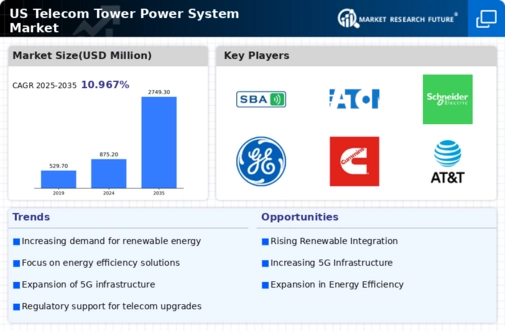The US Telecom Tower Power System Market is characterized by a dynamic competitive landscape, driven by the rapid expansion of telecommunications infrastructure and the increasing demand for reliable energy solutions. The market encompasses a wide range of players, including specialized telecom infrastructure providers and energy management companies, all vying for market share in a sector that is witnessing technological advancements and regulatory changes. Competitive strategies among these players often focus on innovation, efficiency, and sustainability, with companies investing heavily in research and development to enhance their offerings.
The growth of 5G technology and the subsequent need for robust power systems to support increased data traffic and connectivity are further intensifying competition in this market, as firms seek to position themselves as leaders in delivering effective solutions to telecom service providers.SBA Communications has established a significant presence in the US Telecom Tower Power System Market, primarily through its extensive portfolio of telecom infrastructure assets and strategic partnerships. The company’s strengths lie in its robust operational capabilities, including a nationwide network of tower sites that are optimized for power efficiency and reliability.
SBA Communications effectively leverages its infrastructure to provide effective power solutions that meet the ever-evolving needs of telecom operators facing increasing demands for peak performance.
This strategic positioning not only enhances the company's competitive edge but also solidifies its reputation as a trusted partner in the American telecom sector. With a proactive approach to enhancing existing tower facilities and investing in new technologies, SBA Communications continues to strengthen its market position in response to growing industry challenges.Eaton Corporation, meanwhile, has carved out a significant role within the US Telecom Tower Power System Market by offering a comprehensive range of power management solutions that cater to the telecommunications sector.
The company's key products and services include advanced backup power systems, energy-efficient power distribution units, and innovative grid management solutions. Eaton's strengths are underscored by its extensive engineering expertise and commitment to sustainability, which resonate well with telecom operators looking to optimize energy use and reduce carbon footprints. Furthermore, Eaton Corporation actively pursues strategic mergers and acquisitions to enhance its technological capabilities and expand its market reach in the US.
These endeavors allow the company to stay at the forefront of industry trends and challenges, reinforcing its competitive advantage as a leading provider of integrated power solutions tailored for the unique needs of telecom infrastructure in the region.
















